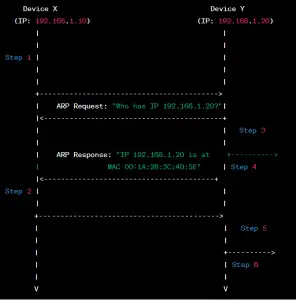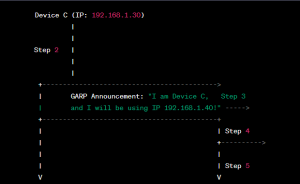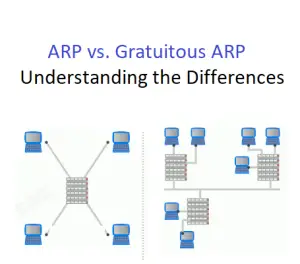In the world of networking, the Address Resolution Protocol (ARP) plays a critical role in facilitating communication among devices within a local network.
To enhance this process, Gratuitous ARP (GARP) comes into play, serving a specific purpose that sets it apart from regular ARP.
In this article, we will embark on a journey to explore both protocols, providing real-life examples to illustrate their differences, and highlight the best scenarios for their usage.
ARP – Address Resolution Protocol
Imagine a bustling office with numerous computers, printers, and other devices interconnected through a local network. Each device has a unique IP address assigned to it, allowing them to communicate within the network. However, to exchange data efficiently, devices need to know each other’s Media Access Control (MAC) addresses. This is where ARP comes in.
In simple terms, when Device A wants to communicate with Device B but only knows its IP address, it sends out an ARP request to the entire local network, asking, "Who has IP address X?". The device with IP address X responds, "I have that IP address, and here is my MAC address Y!". This exchange enables Device A to learn the MAC address of Device B, allowing them to communicate seamlessly.
GARP – Gratuitous Address Resolution Protocol
Now, let’s shift our focus to GARP, which operates differently from regular ARP. Instead of searching for another device’s MAC address, GARP is used for an entirely different purpose.
In this scenario, let’s simplify and present the process of Gratuitous ARP (GARP) more easily:
Device C (IP: 192.168.1.30) wants to join the network and use IP address 192.168.1.40.
To avoid IP address conflicts, Device C broadcasts a GARP announcement to the entire local network, declaring, “I am Device C, and I will be using IP address 192.168.1.40!”
All devices in the network receive the GARP announcement.
Since no device responds or objects, Device C can safely use IP address 192.168.1.40 without causing conflicts.
In this straightforward explanation, we highlight the key steps of the GARP process, making it easier to understand how Device C ensures its chosen IP address is available for use.
Comparison: ARP vs. Gratuitous ARP
| Feature | ARP | Gratuitous ARP |
|---|---|---|
| Purpose | Resolving IP to MAC mappings | Duplicate IP address detection and network redundancy |
| Triggered By | ARP Request | User or System Initiated |
| Response Required | Yes | No |
| Destination MAC | Specific Device’s MAC Address | Broadcast MAC Address (FF:FF:FF:FF:FF:FF) |
Let’s summarize the differences between ARP and Gratuitous ARP using examples:
ARP:

Suppose Device X (IP: 192.168.1.10) wants to communicate with Device Y (IP: 192.168.1.20) in the same network. However, Device X only knows the IP address of Device Y and not its MAC address.
- Purpose: ARP’s main purpose is to resolve IP addresses to MAC addresses. Device X sends out an ARP request, “Who has IP address 192.168.1.20?”. Device Y responds, “I have that IP address, and my MAC address is 00:1A:2B:3C:4D:5E!”. This allows Device X to establish communication with Device Y.
- Triggered By: ARP is triggered by a device wanting to communicate with another device and needing to discover its MAC address.
- Response Required: A response is necessary for successful communication. Without the response from Device Y, Device X cannot establish a connection.
- Destination MAC: In ARP, the request is sent specifically to Device Y’s MAC address.
Gratuitous ARP:

Now let’s consider the scenario where Device C (IP: 192.168.1.30) wants to join the network, but before doing so, it needs to ensure that the IP address it intends to use (IP: 192.168.1.40) is not already in use.
- Purpose: GARP’s primary purpose is to detect and resolve IP address conflicts and facilitate network redundancy.
- Triggered By: GARP is triggered by Device C, either manually by a user or automatically by the system.
- Response Required: No response is needed for GARP to fulfill its purpose. The announcement serves as a proactive measure.
- Destination MAC: In GARP, the announcement is broadcast to all devices on the local network.
Best Use Cases
ARP finds its best use case in everyday network communication, allowing devices to discover each other’s MAC addresses for seamless data exchange. On the other hand, GARP is more situational and finds its best application in the following scenarios:
- Duplicate IP Address Detection:
GARP is invaluable in detecting IP address conflicts. When Device C sends out a GARP announcement, it immediately discovers if IP address Z is already in use by another device. This allows network administrators to take swift corrective action and ensure smooth network operations.
- Network Redundancy:
In cases where high availability and network redundancy are essential, GARP can play a crucial role. If one device fails, another standby device can quickly announce its claim to the failed device’s IP address using GARP, seamlessly continuing the services without disruption.
Conclusion:
In conclusion, both ARP (Address Resolution Protocol) and Gratuitous ARP (GARP) play vital roles in networking, but they serve distinct purposes. ARP is primarily used for resolving IP addresses to MAC addresses, facilitating seamless communication between devices within a local network. On the other hand, GARP serves as a proactive mechanism to detect and resolve IP address conflicts and to enable network redundancy when required.
Let’s summarize the differences between ARP and GARP in a simple table:
| Feature | ARP | Gratuitous ARP |
|---|---|---|
| Purpose | Resolving IP to MAC mappings | Detecting IP address conflicts and network redundancy |
| Triggered By | ARP Request | Device C, manually or automatically triggered |
| Response Required | Yes | No |
| Destination MAC | Specific Device’s MAC Address | Broadcast MAC Address (FF:FF:FF:FF:FF:FF) |
ARP ensures devices can communicate effectively within a network by discovering each other’s MAC addresses, while GARP proactively checks for IP address availability to avoid conflicts when new devices join the network. Furthermore, GARP facilitates network redundancy, allowing seamless service continuity in case of device failures.
By understanding these protocols’ unique features and use cases, network administrators can optimize network stability, minimize disruptions, and ensure efficient data communication. Both ARP and GARP are essential tools in the networking toolbox, working hand-in-hand to build robust and reliable local networks.

